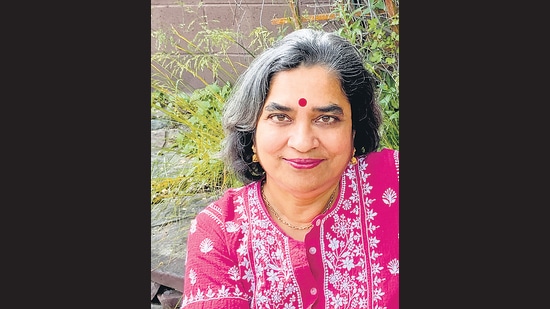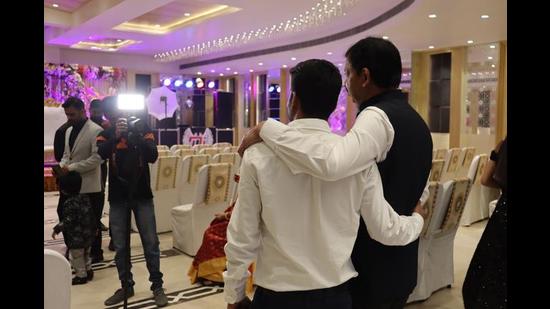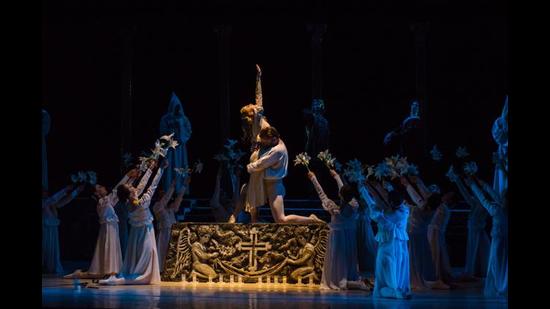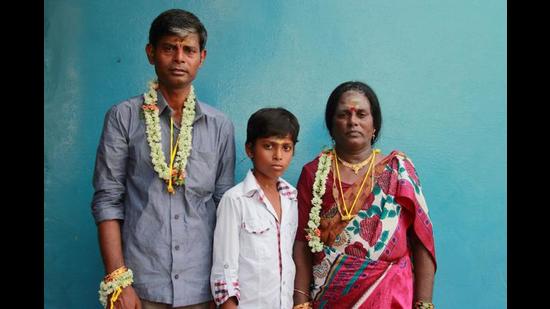Interview: Ruth Vanita, author, Love’s Rite: Same Sex Marriage in India
Ruth Vanita is an ardent supporter of same-sex marriage in India
Ruth Vanita is an ardent supporter of same-sex marriage in India. A Professor of English and Co-director of South and South-East Asian Studies at the University of Montana, she has painstakingly documented same-sex marriages that have taken place in India even in the absence of legal recognition from the state.

How did you feel when the Government of India recently filed an affidavit in the Delhi High Court implying that same-sex marriage is incompatible with Indian laws and culture?
I expected it. The same argument has been made in every country where the matter has gone to court, including the US. In every country, marriage equality has taken a long time to be established.

In the book Love’s Rite: Same Sex Marriage in India and the West (2005) you wrote, “While state recognition is desirable, the state’s refusal to recognize a union as marriage does not mean that the union is not a marriage.” Please help us unpack that.
The book is going to be reissued this summer as Love’s Rite: Same-Sex Marriage in India, with a new cover, new preface and a list of all the same-sex couples I have been able to record, who either got married or committed joint suicide since 1980. Many governments in history have refused to recognize certain marriages. However, particular communities did recognize these marriages. For example, before 1753, Jewish and Quaker marriages were not recognized in England, and before 1967, several states in the US did not recognize marriages between blacks and whites. Nevertheless, these marriages took place. They were real marriages. Reality is not defined by the state. The state may recognize reality or it may not but reality persists.
So also, same-sex couples all over the world have been getting married by religious and other ceremonies for centuries, and have been living as spouses. In 1987, the first such marriage in India was reported between two policewomen, Leela Namdeo and Urmila Srivastava. This was before same-sex marriage was legal in any country. Since then, many more have taken place.
The interesting thing is that most of the young couples from 1980 onwards, all over India, who have been getting married by religious rites or committing joint suicide, have been low-income and non-English speaking. Most of them did not know about any LGBT or feminist movement. They include factory workers, farm labourers, nurses, fisherwomen, Hindus, Muslims, tribals and Dalits. They are mostly women but there are a few men as well.
These are the true pioneers (and often martyrs) of marriage equality, and Love’s Rite focuses on their stories because these couples are barely remembered. Today, newspapers report celebrity or upper-class same-sex weddings and keep declaring that these are the first ones in a particular state or city whereas, in fact, there have been earlier weddings of little-known couples in most of these places.
Much before the twentieth century too, same-sex couples have been getting married and I have documented some of these in Love’s Rite.
For most people from low-income groups, family recognition is more important than government recognition. In many cases, their families came around and participated in the wedding ceremonies. Government recognition is required when it comes to certain rights, such as the right to inherit, the right to make decisions for one’s spouse’s health or funeral, the right to get a visa, and so on.

You have also argued that “marriage has varied so widely over time and space that its only core component is commitment.” What is the nature of this commitment in physical, emotional and social terms? Is it the same as or more than monogamy and exclusivity?
The kind of commitment varies in different times, places and communities, and even from couple to couple. Different couples work out all sorts of arrangements between themselves. Obviously, the commitment is not to monogamy alone, as there have been polygamous and polyandrous marriages throughout history. Those are legal and valid marriages too.
There are married couples who live in different cities; there have been celibate couples; there are couples who maintain separate finances. Basic commitments include looking after one another, especially in sickness and in crises; discussing and sharing major decisions; and treating one another as primary companions.
Over time, and even in the last century, marriage laws have changed beyond recognition, especially with regard to women’s rights in marriage, the matter of adults’ choice to marry, and the question of divorce. It’s not as if marriage has been an unchanging institution, and this is the first legal change ever demanded.
How can literature contribute to contemporary debates on same-sex marriage that are carried out in courts, media and activist spaces largely through the language of the law?
Literature depicts how people actually live and also imagines how they can live or would like to live. Literature describes the rights that individuals give to one another and the struggles they experience when facing a hostile or conflicted society. Literature also depicts and imagines the joys of relationships – cross-sex and same-sex friendships and marriages.
In my book, Gender, Sex and the City: Urdu Rekhti Poetry in India, 1780-1870, I translated Urdu poetry and prose from the 18th and 19th centuries which describe the rituals some women performed to form couples and to marry each other.
What made you compare the relationship between Mallika and Lalithambika – the two women from Kerala who attempted suicide in 1980 and left a note requesting to be buried together – to the literary characters Romeo and Juliet as well as Heer and Ranjha?
Not just Mallika and Lalitha but numerous other couples (same-sex and cross-sex) have preferred to die together rather than be separated. In 1988, two nurses, Gita and Kishori, hanged themselves in a Gujarat village. In 1996, two unnamed peasant girls committed joint suicide in Vypeen; in 2002, Sumathi and Geetalakshmi did the same in Tamil Nadu, and left suicide notes asking to be cremated together. There are many instances: in 2004, Suchita and Seema in Mandar village, Maharashtra; in 2008, Asha and Ganeshia in Durg; Chhattisgarh; in 2007, Swapna and Sucheta in Sonachura village, Bengal; in 2008, Asha and Bhavna in Bavla, Gujarat. In 2007, two young men, Jayanta and Swapan committed joint suicide in Dihibagnan village, Bengal. These are just a few of hundreds reported, and for every one reported there are hundreds more unreported. These suicides are protests. These young people would rather die than be separated.
Numerous other couples eloped and married but were forcibly separated by their families. Some have managed to live together either with or without family support. Many relationships fall apart because of the lack of social support.
The stories of Heer-Ranjha and Romeo-Juliet are a universal type of love-story told around the world. But these are not just stories. These tragedies continue to happen even today, both for male-female and same-sex couples. The fact that both cross-sex and same-sex couples have the same experience suggests its universality.

How did this idea of being married in death, and beyond death, take root in societies all over the world that do not provide social or legal sanction to same-sex marriages?
I think this is an Asian phenomenon, at least in modern times. In countries like the US, suicide rates among gay people are higher than among others but these are individual suicides. In Western countries, people claim an identity like “gay” or “lesbian.” In India, it is more common for a young person to resist marriage and declare a desire to live with a same-sex partner than to declare an individual identity. This is changing now in cities, especially among the English-speaking population. Hijras have been an exception because the community and identity are visible to all.
Why do you locate homophobia in modernity and nationalism rather than religion?
I locate it in colonial rule, not in modernity or nationalism per se. Up to the mid-nineteenth century, we find many individuals or couples inclined to same-sex relations but do not find instances of them being persecuted. Most people did marry a person of the other sex but some also continued to have same-sex relations. The Kamasutra depicts men having relationships with other men. Other literature depicts women having relationships too. This occurred among Hindus as well as Muslims. The book Same-Sex Love in India: Readings from Literature and History contains writings about same-sex relationships from 15 Indian languages, over a period of more than 2000 years.
It was after a certain type of modernity appeared with British colonialism, post-1857, that the anti-sodomy law was imposed and implemented (in 1861). In the 1820s, for example, a number of Muslim poets wrote freely about male-male and female-female relations. A range of such writing is found from the times of the Mahabharata and Kamasutra onwards. In the 1920s, when Hindi writer Ugra, whose stories I have translated, wrote about male-male relations, he was told that this subject should never be mentioned in writing. What had been considered unspeakable in Christian Europe for over a millennium but had never been unspeakable in India, had now become unspeakable.
Your first novel Memory of Light was released in 2020. How did your scholarly work on same-sex relationships help you conjure up a fictional tale about the love between Nafis Bai and Chapla Bai in 18th century Lucknow? What can 21st century India learn from them?
I had translated and written about Urdu poetry written, mostly in Lucknow but also in Hyderabad, about male-male and female-female love. Sa’adat Yar Khan “Rangin” (1757-1835) was one of those who wrote a lot of poetry about women’s lives and loves, especially female-female friendships and love relationships. He wrote (in prose) about the rituals women performed to become couples and to get married to each other “among their female companions.” Some, but not all of these women were tawaifs. Insha Allah Khan “Insha” (1752-1817) also wrote some wonderful poetry about such relationships, and in one poem he describes a dancer called Chapla. In another poem, he imagines the relationship of lightning (chapla) and moonlight (chandni) as a love relationship between two women.
I set the love story between Chapla and Nafis (who, in my novel, is given the pet-name Chandni, by poet Insha) in this world, which had caught my imagination. Historical figures like Insha, Rangin and the poet Jur’at (who wrote a long poem about the real-life romance between a male poet and a tawaif) are characters in the novel.

You have argued that “changes in practice precede changes in written law” because spouses used to separate and remarry much before divorce and remarriage got legal recognition. How do you make sense of the government’s opposition to same-sex marriages?
Even today, many male-female couples separate and live apart without legal divorce. Many marry by religious rites, separate and then remarry, again by religious rites. All this is outside government purview.
Likewise, many same-sex couples live together in the way a married couple would. I know three female couples, now in their sixties, seventies and eighties, who lived in this way in Delhi and also raised children together. People don’t wait for legal recognition in order to live their lives.
But the absence of legal rights makes it much harder to live.
Your research challenges the idea that the desire to get married is prevalent only among Hindu upper caste same-sex couples from urban, elite, English-speaking backgrounds. Raju, the Dalit woman, who eloped and got married to her Jat friend Mala in 2004 is a case in point. Why is their story so rarely told and cited in discussions of same-sex marriage in India?
In Love’s Rite, I have told the stories of many such couples. In fact, the vast majority of couples I have documented are lower-income, rural and small-town, non-English speaking. Most of them had never heard any word like “lesbian” or “gay.” They did not use any such words for themselves. They just said they loved each other, they could not live without each other, and they wanted to get married to each other.
Here are some examples: in 1998, Sita and Rupa, textile workers, got married by Hindu rites in Nepal; in 2001, Jaya and Tanuja, nurses, got married in Ambikapur, Bihar; in 2004, Mustafa and Harfan, Muslim men, married by Hindu rites in Ghaziabad; in 2005, Ranu and Neetu married and then attempted joint suicide in Kanpur; in 2005, Nitima and Laxmi, tribals, married by community rites in Bharbaria, Jharkhand; in 2005, two unnamed women tried to marry and were forcibly separated in Mundmuhan and Sialia villages, Orissa; in 2006, Bateka and Maleka, tribals, married by community rites in Dandabadi village, Orissa; in 2006, Ritu and Baljit, suspected of being married, were ordered by the panchayat to leave their village Mirpur Jattan, Punjab; in 2007, Kumari and Varalakshmi, Christians, exchanged Bibles and then married by Hindu rites in Sabbavaram, Andhra Pradesh; in 2007, Baljit and Rajwinder, two Sikh girls from Hassanpura Kalan and Hassanpur Khurd villages, Punjab, married by Hindu rites; in 2008, Kamlesh and Lakshmi married and then committed suicide in Panna, Madhya Pradesh; in 2009, two men, Wahengbam and Karam married in a private ceremony in Manipur. In 2015, two girls in Champaran, Bihar, married by Hindu rites. One of them was a Muslim. These are just a few from a much longer list.
This is not a boring list; these names are important. Pay attention to the names and the places. The reason these small-town and rural, working-class and lower-middle-class couples are forgotten is that all of us, the English-educated, the media, and many activists and theorists, prefer to focus (positively or negatively) on the urban and the glamorous.
The idea that all the couples are Hindu is ludicrous. Read the names closely. There are Hindus, Muslims, Christians, Sikhs, and tribals.
One of the most moving reports I have read is about Thingring Basumatary, a daily-wage labourer, and Roinathi Basumatary, a domestic help. The two women are Bodos. They were in love since they were young girls, and they got married in a Mahamaya temple in 1999. They were publicly whipped in their own community and had to flee. They moved from one village to another but no one would allow them to settle down. Finally, in a Bodo village called Simlaguri, they found acceptance and are happily living there since then. In 2006, the villagers asked candidates in the MLA elections to legalize the marriage of the two women. Candidates of both parties promised to consider the demand. I have written about these women in Love’s Rite.
In many countries, for example, in the US, the legal suits for same-sex marriage were not filed by movement activists but by ordinary couples who considered themselves married and wanted their rights. In fact, many movement leaders opposed the demand, saying it was premature or it was not progressive enough.
How do you respond to the idea that same-sex couples must not get married as marriage is a patriarchal, heteronormative and casteist institution that is inherently oppressive?
I find it most amusing. On the one hand, the state tells us same-sex couples must not get married, and on the other hand, activists tell us the same, but for supposedly different reasons. Does anyone have the right to tell anyone else that they must or must not get married?
Those who do not want to marry are free not to do so. Those who do want to marry should have the same legal right to marry as the majority of citizens have.
Activists’ crusade is only against same-sex marriage. If they are really anti-marriage, let them try to abolish cross-sex marriage. Do they boycott all marriages? Do they tell heterosexual friends and relatives that they “must not” get married because it’s a patriarchal institution? Or is it only same-sex couples who must bear the burden of giving up their rights?
As for patriarchal institutions, which institution is not patriarchal? The university in its modern form descends from the Christian monastery and is very much a patriarchal institution. The word “professor” refers to one who professes the Christian faith. “Must” we therefore not study or teach at universities?
Institutions are not frozen in time. They change every moment, and they change because of the people who are part of the institutions. Why is marriage any different?
In Love’s Rite, I also show that historically, marriage is not a heterosexual institution alone. There were same-sex marriages and marriage-like relationships in ancient Greece, ancient Rome, medieval Europe, ancient China and Japan, and ancient and medieval India.
Marriage is not “inherently oppressive.” It can be oppressive and it can be liberating. It can be boring and it can be consoling. It is many things at once just as people are many things at once.
What makes you say that, at times, heterosexual marriages may be far more unconventional, flexible and compassionate than they are given credit for?
Both history and experience tell me that. We tend to stereotype heterosexual marriages as if all of them are the same. In fact, they vary widely.
It is important to note that many male-female couples choose not to have children or they cannot have children because they are infertile or the woman has passed the child-bearing age. Is the marriage of two people in their seventies not a legal marriage? Is the marriage of a woman who has had a hysterectomy not a legal marriage? Are all heterosexual couples forced by the law to have children? The argument that same-sex couples cannot marry because they cannot produce children together is completely illogical.
Several Gandhian couples chose to have celibate or childless marriages in order to devote themselves to community service. Such were the marriages of the Kripalanis and also of Jayaprakash Narayan and Prabhavati Devi. The latter marriage was celibate on the wife’s insistence. The writers Virginia and Leonard Woolf had a celibate marriage and had no children, but it was a companionate and mutually-supportive marriage.
What a married couple agrees on and does together is largely a private matter. Only the two people involved know what kind of arrangement they have regarding financial, sexual and other matters. I have known several heterosexual couples where the spouses live in different cities and meet during vacations. I know several where their sex life dwindles but they are nevertheless best friends. There are also many open marriages. They do not have to announce this in public but they may practice it.
Chintan Girish Modi is a writer, educator and researcher who tweets @chintan_connect



